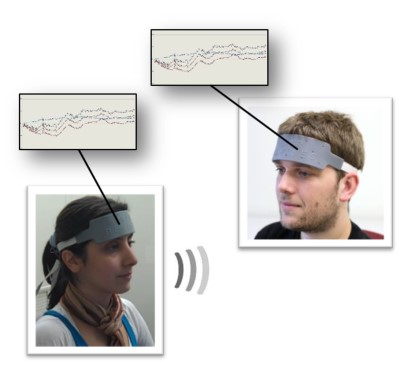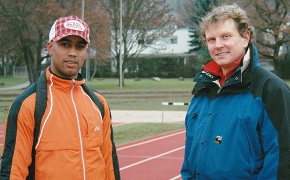|
In This Issue...
- Brain Imaging Tool Measures How Speakers' and Listeners' Minds Align
- Neuropharmacology of emotional systems
- Interview with Dr. Mikhail (Misha) Plenikov
- The City of Hiroshima
- Hobby Much?
- Trending Science
- Member News
Brain Imaging Tool Measures How Speakers' and Listeners' Minds Align
by By Hasan Ayaz, School of Biomedical Engineering, Science and Health Systems, Drexel University
Drexel University biomedical engineers in partnership with Princeton psychologists, developed a portable brain-imaging device to see just how brains sync up when humans communicate. The study investigated the brain to brain hemodynamic correlation during natural verbal communication and demonstrated that brain function synchronization occurs only when there's information exchange, i.e. listeners capture the information being explained by the speaker.
 For the study, researchers applied functional near-infrared spectroscopy (fNIRS), an optical neuroimaging method that uses near infrared light to measure cortical oxygenation changes. fNIRS is an emerging neuroimaging approach that has become increasingly popular due to the safe, portable, and cost-effective nature of the hardware, and improved algorithms for signal processing and feature extraction. For the study, researchers applied functional near-infrared spectroscopy (fNIRS), an optical neuroimaging method that uses near infrared light to measure cortical oxygenation changes. fNIRS is an emerging neuroimaging approach that has become increasingly popular due to the safe, portable, and cost-effective nature of the hardware, and improved algorithms for signal processing and feature extraction.
Researchers utilized wearable fNIRS sensors to record brain activity of speakers telling stories and listeners comprehending the audio playbacks. Listeners' brain activities were found to be correlated with the speakers' with a delay. This between-brain correlation ceased when the verbal communication failed.
Researchers further compared the fNIRS and functional Magnetic Resonance Imaging (fMRI) recordings of listeners' comprehending the same story and found a correlation across listeners, only when they were listening to the same speaker. The fNIRS oxygenated hemoglobin concentration changes and the fMRI blood oxygenation level dependent signal in brain areas associated with speech comprehension were coupled. This correlation between fNIRS and fMRI was only present when the same story data was compared, that is same speaker is listened, from each modality and vanishes when different stories data were compared, further highlighting the consistent cross-modality nature of the spatiotemporal brain activation pattern for the story comprehension.
The study overall demonstrated that fNIRS is a feasible tool for investigating brain-to-brain coupling during verbal communication. As fNIRS sensors are relatively low-cost, can be miniaturized, and even built wireless and battery operated, these results highlight the potential of broad utilization of this approach in every day settings for augmenting communication and interaction.
Reference: Liu, Y., Piazza, E. A., Simony, E., Shewokis, P. A., Onaral, B., Hasson, U., & Ayaz, H. (2017). Measuring speaker-listener neural coupling with functional near infrared spectroscopy. Sci Rep, 7, 43293. doi:10.1038/srep43293
http://www.nature.com/articles/srep43293
Neuropharmacology of emotional systems
by Markus Fendt, Institute for Pharmacology and Toxicology & Center of Behavioral Brain Sciences, Otto-von-Guericke University Magdeburg, Magdeburg, Germany
Emotions are essential to adaptive behavior in humans and animals. For example, potentially dangerous situations induce the emotion fear which then motivates defensive behavior (“fight or flight”, alongside many other options) as well as the appropriate autonomic changes. Importantly, fear-inducing experiences are rapidly learned about and long remembered. Thus, the organism can better cope with future dangerous events.
There are several reasons, why my group is interested in investigating the neural basis of emotions. Primarily, we would like to gain a better understanding of how emotions modulate behavior. Understanding the neuropharmacological basis of these emotions is a prerequisite to developing novel strategies to treat and cure pathological emotions in humans (depression, anxiety disorders, etc.). Additionally, paradigms of emotional learning, e.g. fear conditioning, are excellent models for investigating general mechanisms underlying learning and memory. Since emotional states can also be communicated by visual, auditory and olfactory signals, studying emotions can help to achieve greater understanding of communication and social behavior.
My group, which currently includes 1 postdoc, 2 PhD students, 5 MD students, 1 master student and 2 technicians, is primarily focused on two main projects. The first one is part of the collaborative research center “neurobiology of motivated behavior“ (http://www.sfb779.de/en/index.html) and is focused on the mechanisms of event learning. Event learning refers to all possible associations animals (and of course humans, too) can learn during an aversive experience. It is known that cues predicting an aversive event are learned as conditioned fear stimulus. However, if a cue is present immediately after the offset of an aversive event, in the moment of relief, this cue becomes a conditioned relief stimulus and is able to induce appetitive-like behavioral changes. Over the past several years, we investigated the neural mechanisms underlying relief learning and found that relief learning is mediated by the brain reward system, i.e. the mesolimbic dopamine system. Both, accumbal dopamine D1 and D2 receptors are involved in the learning and retention of conditioned relief. A recently published study from our laboratory demonstrated that an interaction between accumbal dopamine D1 and NMDA receptors is necessary for the acquisition of conditioned relief (Bergado Acosta et al., 2017). Currently, we have shifted our focus to safety learning, i.e. the learning that a cue predicts the absence of aversive events. Human studies suggest that impaired safety learning is a biomarker of several anxiety disorders.
The second main project instead focuses on the role of neuropeptides in normal and pathological fear. For example, we would like to understand the role of neuropeptide S in the regulation of fear and anxiety. It is known from human studies that a polymorphism in the NPSR gene is linked with panic disorders. In mice, a knockout of this gene leads to a mild anxiogenic-like phenotype, however, the effects of the knockout in animal models of anxiety disorders have been poorly investigated so far. Another very interesting neuropeptide is orexin, also called hypocretin. Orexin is well known because of its role in wake/sleep regulation. However, recent studies revealed that orexin is also involved in the modulation of fear and anxiety. For example, orexin-deficient mice have an anxiogenic-like phenotype but are normal in fear conditioning (Khalil & Fendt, 2017). Several students’ projects in our group investigate the role of these two and further neuropeptides in pathological fear and anxiety.
Based on previous experience, one of my favorite behavioral readout in many of these experiments was and still is ultrasonic vocalization (USV). I performed my Diploma and Ph.D. thesis in a department whose head (Hans-Ulrich Schnitzler) is one of the world’s leading scientists in bats’ echolocation research. Therefore, the department was well-equipped with devices to record and to playback ultrasounds. I had some good friends among the ‘bat colleagues’ with whom we started to collaborate and examined among others rats’ ultrasonic vocalization. I recall the frustration in producing the first data as we could not find any effects when rats’ alarm calls were played back on conspecifics. However, our later experiments suggest that the meaning of these calls may have to be learned first. After leaving this department, I did not perform USV recordings for a longer time. A few years ago, we started to record USV in some of our experiments again. We will present and discuss some of these new USV findings at the symposium “Species-specific signals for protection of the social group”, organized in conjunction with Yasushi Kiyokawa from Tokyo, at the next IBNS conference.
Recent publications:
Bergado Acosta JR, Kahl E, Kogias G, Uzuneser TC & Fendt M (2017) Relief learning requires a coincident activation of dopamine D1 and NMDA receptors within the nucleus accumbens. Neuropharmacology 114: 58-66.
Khalil R & Fendt M (2017) Increased anxiety but normal fear and safety learning in orexin-deficient mice. Behav Brain Res 320: 210-218.
Interview with Dr. Mikhail (Misha) Pletnikov
Subject: Big names or big ideas: Do peer-review panels select the best science proposals? http://science.sciencemag.org/content/348/6233/434
DLM - Dr. Pletnikov, you are familiar with the recent article in Science magazine concerning peer-reviewed and its effectiveness in choosing innovative ideas to fund. Do you agree with the article's conclusions that peer review is effective?
 Dr. Pletnikov: In general, yes I do. Of course, the 'devil is in the details' and it has become very difficult to fund all of the exceptional proposals submitted to the funding agencies. The competition has become truly fierce. When I came to the United States in the late 1990s, NIH funding was doubling in size and there was a much better opportunity for a multitude of proposals to be funded. Now, in this era of limited resources, it is far more difficult for all the good ideas to be funded. Dr. Pletnikov: In general, yes I do. Of course, the 'devil is in the details' and it has become very difficult to fund all of the exceptional proposals submitted to the funding agencies. The competition has become truly fierce. When I came to the United States in the late 1990s, NIH funding was doubling in size and there was a much better opportunity for a multitude of proposals to be funded. Now, in this era of limited resources, it is far more difficult for all the good ideas to be funded.
DLM: One of the criticisms that is often leveled at peer-review is that it is inherently conservative – that true innovation is often not funded because it is too high risk to do so.
Dr. Pletnikov: Well I have mixed feelings about this critique. In some sense, NIH R01 grants are a bit conservative and may indeed work against truly innovative ideas. For one thing, most reviewers are more comfortable with significant amounts of pilot data and often this means that the hypotheses have truly been already established. I also think that there is a bias toward innovation in technology when compared to innovation in ideas themselves.
On the other hand, I have found that in NIH R21 proposals, only the really innovative and groundbreaking proposals have any chance of being funded. In the areas of mental disorder, disease and addiction, only the high risk/high innovation proposals are truly taken seriously for funding.
So I would argue that the NIH approach is fairly well-balanced between high risk/innovative proposals and low risk/high return on investment proposals in terms of funding. It depends on the program and on the panel as to where the balance ends up in any given review.
DLM: Another criticism that I've often heard about peer-review is that it's biased towards established institutions. In effect, there is a 'good-old-person' network where peer reviewers come from established institutions and those institutions and up the majority of funded proposals and the cycle continues. What are your thoughts on this?
Dr. Pletnikov: Well I think that's probably a legitimate criticism, although I'm not sure I would consider it entirely negative. Part of any research activity are the facilities and environment in which the research must take place. I think it's legitimate to score institutions such as Harvard University higher than a college or university with far less resources. I suppose that to overcome this you could create truly anonymous proposals in which the individuals and the institution are hidden from the reviewers. I'm not sure how well this would work, since the reviewers are likely to be familiar with the work being done in the field and thus be able to recognize from where the proposal is coming. It is also important, as I said, for reviewers to appreciate the facilities and resources available to the proposing researchers. Again, I suppose it would be possible to simply list the facilities and not identify the institution, but I suspect that this would be difficult to do in a truly anonymous fashion.
DLM: Thank you, Dr. Plenikov. From your years of experience, do you have any advice for those seeking funding?
Dr. Pletnikov: Well, I am not sure I can add very much to what's already available from various sources. There are a number of well written handbooks and guides for proposal development and I strongly urge anyone considering submitting a proposal to review these handbooks and guides. Many of them are very useful. I also think one should be actively involved in the process. Of course, one needs to have a certain reputation in the field to be asked to review NIH proposals but one can volunteer to review proposals for the NSF and this again will give you a sense of how the peer review process works. I also strongly urge anyone considering writing a proposal to talk to people involved in the process. Talk to people at the NIH – talk to the program directors and get a sense of what proposals are being funded and what types of research are actively being sought. And of course, attend conferences and meetings in the field, such as our upcoming annual meeting in Hiroshima, Japan. Science in the modern era thrives on collaboration – the era of solitude in science where the individual researcher working alone and in isolation can make major discoveries has passed. Today, it is the team working together that makes the new discoveries and advances the field and disciplines. Networking is an absolutely essential skill for success in science in the modern era.
The City of Hiroshima
Hiroshima City is the capital of the Hiroshima Prefecture and is the principle city in the Chugoku region of Honshu, the largest island in Japan. The name means broad or wide island and dates from 1589, when Terumoto Mori began construction of a castle on a delta in the region. However, the region's history extends far earlier with evidence of various settlements in the region dating from Japan's Jomon (13,000 - 300 BCE) and Yayoi periods (300 BCE - 300 CE). Hiroshima City has always been at a crossroads - between the land and the sea, between various cultures zones, the Kinke to the east and the Kita-Kyushu to the west in ancient times, between the various clans of the middle ages, as a transportation hub linking shipping by rail, sea and finally air, and during much of the city's existence, as an interface between Japan and the rest of the world. However, that is not really what most of the world remembers. What the world sees is another crossroad - one that occurred on a single day, in a single instant in August, 1945. A crossroad between the inhumanity and injustice of war and the promise of peace. The Hiroshima Prefectural Industrial Promotion Hall - the Atomic Bomb Dome - was the closest building to the epicenter of the blast to partially survive and reminds us of the direction from which humanity has come. In December, 1996, the Atomic Bomb Dome was designated as a World Heritage site. In 2006, the main building of the Hiroshima Peace Memorial Museum was designated as a National Important Cultural Property and the Peace Memorial Park was selected as a National Place of Scenic Beauty. The Hiroshima 2045: City of Peace and Creativity initiative, begun in 1995, illustrates the hope that the road we have crossed has a bright future.
In addition to these historical sites, the nearby Itsukushima Shrine on Miyajima Island (Officially called the Island of Itsukushima, the name Miyajima is Japanese for 'shrine island') offers a stunning panorama including the natural beauty of Mount Misen and the inspiring human-made torii gate set out in the Seta Island Sea. The Itsukushima Shrine can be enjoyed through an extensive walking path while viewing the torii gate seemingly floating on the water. After sunset, the shrine and torii gate are illuminated until 2300 hours although it is not possible to enter the shrine itself after sunset.
Science has come to Hiroshima City often over the years. In 1996, the 6th World Congress of Cardio-Thoracic Surgeons met in the city, and the 2001 Collegium Internationale Neuro-Psychopharmacologium (CINP) Regional Meeting was held here. In 2003, it was the 18th Planetary Congress of the Association of Space Explorers, in 2009, the Collaborative Meetings on Health Informatics, in 2011, the International Tribiology Conference, and in 2014, the 17th World Congress of Psychophysiology all met in this cosmopolitan city. And in 2017, the International Behavioral Neuroscience Society will be privileged to join this group when it holds its 26th Annual Meeting in Hiroshima City.
References and Guides
Bombings of Hiroshima and Nagaski – 1945. Atomic Heritage Foundation http://www.atomicheritage.org/history/bombings-hiroshima-and-nagasaki-1945
Hiroshima Convention & Visitors Bureau http://www.gojapango.com/travel/hiroshima_history.htm
Hiroshima Poetry, Prose and Arthttp://www.thehypertexts.com/hiroshima poetry prose and art.htm
Japan Guide. Com (http://www.japan-guide.com/e/e2131.html)
O’Bryan, Scott. Hiroshima: History, City, Event as part of About Japan: A Teacher’s Resource, Japan Society (http://aboutjapan.japansociety.org/hiroshima_history_city_event)
Smith, Lydia (2014) Hiroshima Anniversary: What Actually Happened When the Atomic Bomb Was Dropped? http://www.ibtimes.co.uk/hiroshima-anniversary-what-actually-happened-when-atomic-bomb-was-dropped-1459894
The City of Hiroshima – History of Hiroshima (http://www.city.hiroshima.lg.jp/www/contents/1263790328515/index.html)
Hobby Much?
by Markus Fendt
From time to time, I have a discussion with my wife Anna about the interests and hobbies of the colleagues of the other. In my opinion, most of her colleagues (she is working at a puppet theater) are extremely focused on their work and don’t have any hobbies. Therefore, going out with them in the evening is not really entertaining for me since they most often speak about their work which is not very interesting for me as a non-insider. My wife usually agrees but then often adds that my neuroscience colleagues are also like this. In her opinion, I am an exception since I have several hobbies.
Based on this recurrent discussion, I was very amused by the ‘hobby article’ of Robert Gerlai in the IBNS newsletter a few months ago. In fact, I immediately forwarded the article to my wife with the notion “look – also other neuroscientists have hobbies”. Also my wife was very amused by Robert’s article. Not so much because she had to accept that also other neuroscientists have hobbies but because some of Robert’s hobbies are very similar to mine.
Robert’s article starts with the notion “I like speed”. This is true for me, too. However, I don’t like motorsports and windsurfing so much, I especially like fast athletic sports. I started to play basketball when I was 13 years old. A few years later, I discovered track and field athletics. I liked sprinting (100m, 200m) and throwing (javelin, discus), and also made a few decathlons. Sometime later – I just started to study biology – I realized that being a coach is my real passion. I started to train a group of 12-14 years old teenager in our local track and field club. I was very lucky since  some of these teenagers were very talented and became very successful during the next 10-15 years. The most talented one of this group, Marius Broening, a 100m sprinter, represented Germany at several World and European Championships, and 2004 and 2008 at the Olympic Games in Athens and Beijing. Others become nationally successful pole vaulters, javelin throwers and long jumpers. It was quite fascinating and rewarding for me to take part of the athletic (but also personal) development of these young athletes. For many years, I was thinking about to become a professional track and field coach but then, after getting married, after becoming a proud father of two kids and after getting a good job offer from pharmaceutical industry, I decided for the apparently safer job, i.e. being a scientist in ‘Big Pharma’. (Well, it was not so safe than expected and I am meanwhile back in academic research.) some of these teenagers were very talented and became very successful during the next 10-15 years. The most talented one of this group, Marius Broening, a 100m sprinter, represented Germany at several World and European Championships, and 2004 and 2008 at the Olympic Games in Athens and Beijing. Others become nationally successful pole vaulters, javelin throwers and long jumpers. It was quite fascinating and rewarding for me to take part of the athletic (but also personal) development of these young athletes. For many years, I was thinking about to become a professional track and field coach but then, after getting married, after becoming a proud father of two kids and after getting a good job offer from pharmaceutical industry, I decided for the apparently safer job, i.e. being a scientist in ‘Big Pharma’. (Well, it was not so safe than expected and I am meanwhile back in academic research.)
With the move into ‘Big Pharma’, I finished being a coach and started to do more exercise myself. Since this time, I am running 2-3 times per week. Despite it was my passion for many years to make athletes fast, I like to run leisurely. I do it only for health reasons, not to become faster. Also, I like to run in nature and without earphones, i.e. I can enjoy nature’s sounds like for example birdcalls. Interestingly, birds and other animals seem to be less frightened by runners than by walkers. Therefore, I became much more familiar with birds during running. A few years ago, I then started to make field trips on the weekends to ‘catch’ the bird I saw or heard during running with my camera. Meanwhile, I have a nice picture collection of European bird species.
 
Spending a lot of time in nature and taking pictures of birds and other animals is nice if the weather is nice. However, there are also rainy and cold days here in Germany and then, of course, it’s also nice to have some nature in my warm home. Since more than 40 years now, I have pets including aquariums with freshwater fishes. Similar to Robert Gerlai, I bred cichlids for many years. Since a few years, I am more focused on fishes from South America such as Hyphessobrycon eques or Copella arnoldi. Last year, I also started to breed freshwater atyid shrimps. For me, it’s extremely relaxing to sit next to my aquariums and to switch between observing fishes and shrimps and reading a good novel.
 The last hobby, I would like to mention is crafting. I like to work with all kinds of materials but most often I build paper crafts – simply because it’s cheap but it still looks very realistic and there are crafting templates everywhere in the internet. I already built Japanese temples, Italian churches, sailing ships and much more. The nicest crafts decorate my shelves at home or in my office. The last hobby, I would like to mention is crafting. I like to work with all kinds of materials but most often I build paper crafts – simply because it’s cheap but it still looks very realistic and there are crafting templates everywhere in the internet. I already built Japanese temples, Italian churches, sailing ships and much more. The nicest crafts decorate my shelves at home or in my office.
Markus Fendt is group leader and professor at the University of Magdeburg, Germany.
Trending Science
In this column, we will share the latest research, interesting scientific articles and news you can use.
More Support for the Benefits of Sleep on Cognitive Function
Researchers at the University of Tübingen were able to apply machine-based pattern detection algorithms to measure learning during sleep. The researchers used EEG to monitor brain activity in subjects in previously exposed to various images during a variety of training conditions. They then applied a pattern recognition algorithm in an attempt to differentiate between the various images/conditions, in effect, training the algorithm to distinguish between them. This was then reapplied to new test subjects to determine if the program could predict which images the subjects had studied based upon their sleep EEG. This was successful, indicating that human do process specific learning during sleep. Interestingly, the major effect was associated with slow wave, rather than REM. sleep.
Schönauer,M., Alizadeh, S., Jamalabadi, H., Abraham, Pawlizki, A., and Gais, S. (2017). Decoding material-specific memory reprocessing during sleep in humans Nature Communications. Published online May 17 2017 doi:10.1038/NCOMMS15404
Reported in Neuroscience News - http://neurosciencenews.com/sleep-memory-6735/
Member News
 Dra. Rosalinda Guevara Guzmán was presented with a special award granted by the Secretaría de Salud (Health Ministry in Mexico) "DOCTOR MIGUEL OTERO" for her clinical research work. Dra. Rosalinda Guevara Guzmán was presented with a special award granted by the Secretaría de Salud (Health Ministry in Mexico) "DOCTOR MIGUEL OTERO" for her clinical research work.
Dra. Guzmán also honored to enter the Real Academia Nacional de Medicina in Spain, by invitation of Juan del Rey Calero, as a Foreign Corresponding Academic.
And in addition to this, Dra. Guzmán was honored with an invitation to attend the ceremony to give the medal of honor granted to Her Royal Highness Infanta Doña Margarita of Spain in Madrid last May 8th, 2017.
Do you have an interesting hobby or member news to share?
Let us know at [email protected]
|